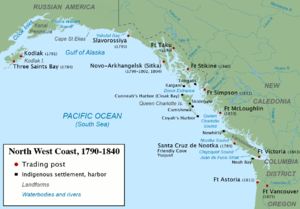Nahwitti (trading site) facts for kids
Nahwitti was once a busy village belonging to the Kwakwakaʼwakw people, a First Nation group. It was a very important place for trading during the maritime fur trade era, which lasted from about 1790 to 1850. Today, Nahwitti is a special area called an Indian reserve. It is managed by the Kwakwakaʼwakw Tlatlasikwala Nation.
You can find Nahwitti near the northern tip of Vancouver Island. It's located at Cape Sutil on Queen Charlotte Sound. It's also close to Hope Island and the Nahwitti River. This area is east of Cape Scott and not far from the old Fort Rupert or the modern town of Port Hardy.
Contents
A Hub for Trade
In the early 1800s, Nahwitti was the main village for the Nahwitti First Nation. It became one of the most popular spots for trading ships from the West. These ships sailed along the Pacific Northwest coast. Nahwitti was the main meeting point for traders and the Kwakwakaʼwakw people.
Hundreds of trading ships visited Nahwitti during this time. Most of them were from Britain and the United States. They mainly wanted to buy sea otter skins. These skins were then taken to China, where they could be sold for a very high price.
Different Names for Nahwitti
Early explorers and fur traders spelled Nahwitti in many different ways. Some common spellings included Newitty, Newhitty, Newittee, Newitti, and Nuwitti. You might also see it as Newetteo, Neuitie, Neu-wit-ties, New Whitty, New Witty, or New Eity.
Early Visitors
Some of the first Westerners to visit this area arrived in the late 1700s. James Hanna explored Sea Otter Cove in 1786. Also in 1786, James Charles Stuart Strange explored Queen Charlotte Sound. He made contact with the Kwakwakaʼwakw people on northern Vancouver Island.
In 1792, Dionisio Alcalá Galiano stopped at Nahwitti. He was sailing all the way around Vancouver Island. In the same year, Robert Gray from the ship Columbia Rediviva also visited and traded in the area.
The Fur Trade Booms
According to a trader named William F. Sturgis, American ships started regular trade at Nahwitti around 1800. Captain Asa Dodge of the ship Alexander visited that year. He bought 600 sea otter skins for a low price.
After this, Sturgis wrote that American trading ships collected 1,500 to 2,000 skins each year at Nahwitti. The people of Nahwitti were very good at bringing almost all the Kwakwakaʼwakw trade through their village.
Busy Trading Seasons
In June 1805, six American ships gathered at Nahwitti. This happened after an attack on the ship Atahualpa at Milbanke Sound. The ships were the Vancouver, Lydia, Pearl, Mary, Atahualpa, and Juno.
Two months later, the ship Caroline visited Nahwitti. Even though it was a very busy trading time, they bought 330 sea otter pelts. American trading ships continued to visit Nahwitti into the 1820s. The ship Pedler often spent the winter at Nahwitti during the 1810s and early 1820s. Other American ships that visited around 1820 included the Hamilton, Rob Roy, Mentor, Frederick, and Lascar.
Changes and New Homes
In 1850 and 1851, the village of Nahwitti was attacked and damaged by the British Navy. Most of the people living there moved to Bull Harbour on Hope Island. The Nahwitti people called their new village on Hope Island "Meloopa."
Many people later moved again to Alert Bay. The village site on Hope Island is still an Indian reserve today, called "Hope Island 1." Near the original Nahwitti village, on Cape Sutil, there is another reserve called "Nahwitti 4."
Later Settlers
Around 1912 and 1913, some European settlers came to the Nahwitti area. However, many people left to join the military for World War I. By 1921, only one elderly person remained in the area.


